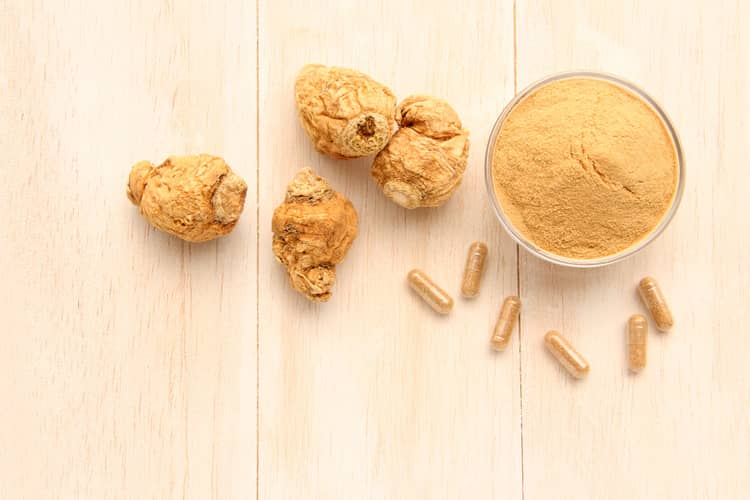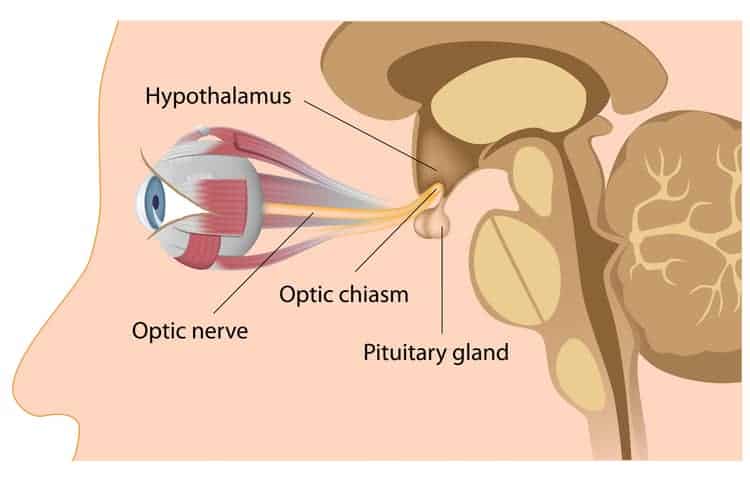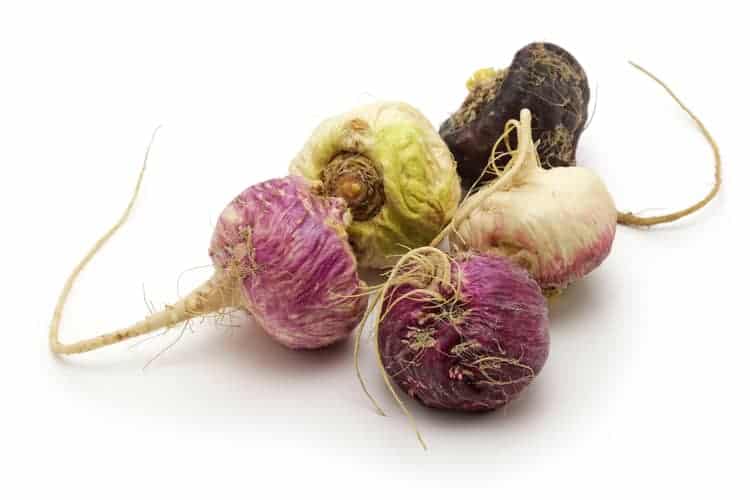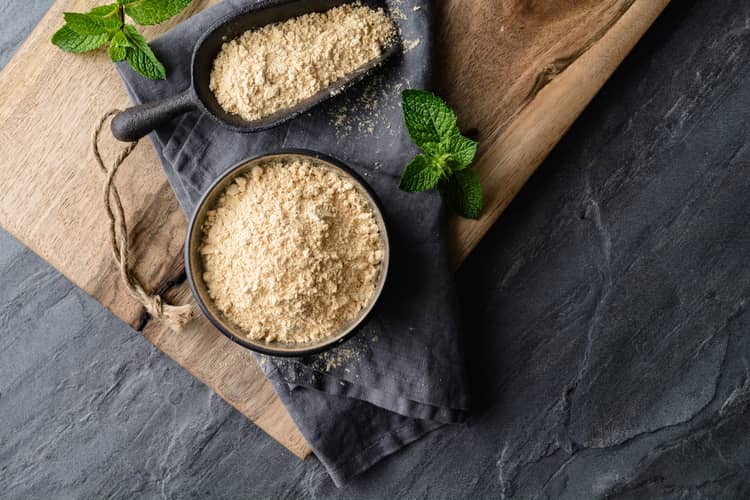
Knowing how to use maca for hormone balance starts with having a basic understanding of what it is, how it works and the different types that are available. But before we get into all those details, here’s a very brief overview of why this hormone-balancing plant is worth paying attention to:
Maca balances hormones by supporting the hypothalamus and pituitary glands. Because these two glands influence the hormones that are produced by other glands (such as the ovaries and adrenals), maca is able to have a wide range of positive effects on the overall state of our hormones.
Now, to help you choose the best maca for your needs and use it safely, this guide is going to cover:
- Historical uses of maca as well as the latest studies on its benefits.
- How and when to take maca.
- Where to get the best quality maca powders and supplements.
By the way if you’re more of a visual person, watch the video below to get an overview of everything that’s in this article:
Note: this post contains affiliate links and I earn a commission (at no additional cost to you) if you use them to make a purchase.
HOW DOES MACA BALANCE YOUR HORMONES?

Maca is an adaptogenic, cruciferous root vegetable that has historically been used in Peru for male and female hormone support. Even though scientists are still working on understanding the exact mechanisms of how maca works, here are a few things that they do know about how maca works on hormones.
1. Endocrine Support
Research shows that maca works by supporting the proper function of the hypothalamus and pituitary.
Both of these glands reside in the brain, with the hypothalamus often referred to as the “master gland.”
This term comes from the fact that the hypothalamus communicates with the pituitary.
Based on the signals that the pituitary receives, it signals other glands, such as the thyroid, adrenals and ovaries.
The signals that these other glands receive from pituitary ultimately affects the hormones that they produce.
So, as you can see, the hypothalumus and pituitary play a major role in the endocrine system. And by supporting these two glands, maca indirectly influences hormone production throughout the body.
2. Alkaloids
Maca is rich in compounds called alkaloids that have been found to have positive effects on the fertility of rats.
And as it turns out, these alkaloids are able to do this by acting on the hypothalamus-pituitary pathway.
3. Sterols
Maca contains a group of compounds called sterols, which are lipids that the body uses to improve the function of the adrenals, ovaries, testicles, thyroid, pancreas and pineal gland.
Given that maca acts on the master gland in the endocrine system, it’s no wonder that it’s used for so many different conditions and situations, including:
- PMS.
- Natural fertility.
- Sexual function.
- Bone health.
- Menopause and post-menopause symptoms.
- Fatigue and low energy.
- Supporting our stress response.
- Depression.
- As a tonic for the elderly.
Note: to learn more about all the above, read this paper from the International Journal of Biomedical Science.
MACA AND HORMONES: COLORS AND SUPPLEMENT TYPES

1. Maca Colors
Although there are various colors of maca available, the most commercialized are yellow, red and black maca.
Yellow maca is the most abundant and generally recommended for everyday support.
Red and black maca are less abundant and therefore, they’re considered more sacred by Peruvian shamans. In addition, red maca is traditionally said to represent feminine energy, while black maca is said to represent masculine energy.
Because of these energetic associations, red maca is often recommended for women (especially for fertility) and black maca is often recommended for men (especially for fertility).
Lastly, it’s worth noting that:
- the different maca colors come with some nutritional differences. For example, red maca has the most glucosinolates, followed by black and yellow maca. These glucosinolates are sulfur-rich compounds that are found in all cruciferous vegetables. Glucosinolates can be particularly helpful for proper estrogen metabolism.
- red and black maca may be too stimulating for some people, while yellow maca tends to be more gentle and agreeable.
- maca’s different colors pertain to the skin only. Once peeled, they all a very similar off-white to pale yellow color.
Based on all of the above, red maca is usually suggested for female hormone support (such as for fertility or menopause), while yellow is suggested for general, every day support.
2. Maca Supplement Types
Dried powder
- You can find each individual color of maca in powder form and you can also find tricolor maca which contains all 3 colors. The tricolor contains higher amounts of yellow, followed by red and black maca.
- The powder is sold either raw or gelatinized (aka cooked maca – no actual gelatin in it).
- Both raw and gelatinized maca are good, but if you have digestive issues, then gelatinized maca is better because it’s easier to digest. Furthermore, Peruvians have traditionally eaten cooked maca, not raw. Given that they have a much longer history of maca use, it’s probably wise to follow their lead 🙂
- The powder can be added to smoothies, oatmeal, warm milk and desserts.
Capsules
- depending on the brand, capsules can be either the whole powder or maca extract.
Tincture
- this is a liquid extract of maca made by soaking maca root in a solvent (such as alcohol or vegetable glycerin). The solvent is able to extract the medicinal components of the herbs.
HOW MUCH MACA TO TAKE FOR HORMONE SUPPORT

The amount of maca needed for hormone support really depends on each individual’s specific hormonal imbalance(s).
- For example, one study looked at the effects of 1.5g of maca and 3g of maca per day on sexual dysfunction induced by SSRIs (antidepressant drugs). The study found that the higher dosage produced more significant improvements.
- Another study that looked at the hormonal effects of maca on postmenopausal women used 3.5 grams a day. That dose was found to improve libido and the psychological symptoms associated with menopause.
Overall, human studies on maca have used daily doses of 1.5g – 3g (about ½ tsp – 1 tsp). Whether you’re using maca powder, capsules or tincture, make sure to read the instructions to figure out how much you’re getting in a serving.
Having said all this, it really pays to talk to your MD, ND or herbalist for a dosage recommendation that would work best for you.
Also, because maca is an adaptogen, it’s generally recommended that you take breaks while using it. The general guideline for using adaptogen is (source):
- one day off each week.
- one week off after six weeks of regular use.
- one month off after six months of regular use.
WHEN TO TAKE MACA: TIME OF DAY AND MENSTRUAL CYCLE PHASE
Time of Day
Since maca is an energizing herb, it’s best to take it in the morning.
Not only will this allow you to benefit from its uplifting effects all day long, but it will minimize the risk of it potentially disrupting your sleep.
Menstrual Cycle Phase
Given that maca is a whole food, some experts say that it can be used at any time during the menstrual cycle.
Yet, others also suggest taking it only for a short time each month.
In this case it really is worth talking to a healthcare provider who understands this herb and how you intend to use it.
They will be able to give you a personalized maca usage plan.
HOW LONG DOES IT TAKE FOR MACA TO BALANCE HORMONES?
Studies show that maca can produce results in as little as 2 weeks or may require longer term usage (several months). For example:
- One study on post-menopausal women found that 6 weeks of maca use improved both psychological symptoms and low libido (source).
- Another study done with men showed that they had an increase in sexual desire after just 2 weeks of maca use (source).
- A study done with men showed that maca improved sperm production and motility after 4 months (source).
Given that maca can address multiple symptoms, how long it takes to work will always vary for each individual.
BEST MACA FOR HORMONES: MENOPAUSE, MENSTRUAL CYCLE AND MORE

These days, I like to get my maca from The Maca Team. This company specializes in maca products only, which they source from Peru. And they’ve been doing so for about 15 years.
Because they focus entirely on maca, I feel like I’m getting a better quality product because they’ve basically had to master every aspect of maca production.
In addition, I do like the fact that they’re a small business and the maca is coming from local Peruvian farmers. In general, smaller farms tend to do a better job of ensuring the quality of their crops (of course there no guarantees, but this is my perception).
Here are some maca supplements from The Maca Team:
Also, make sure to check out their blog for maca recipes. They’ve got lots of smoothies, desserts and other ideas to help you get the most from maca.
FAQs ABOUT MACA AND HORMONAL IMBALANCE
Can you take maca and progesterone together?
A study done with perimenopausal women shows that maca eventually leads to an increase in progesterone levels (source). So, if you’re considering combining maca with progesterone, please check with your doctor first.
Can you add maca to coffee?
Even though maca doesn’t have caffeine, it is a naturally energizing root. Therefore, combining it with coffee may end up being overly stimulating for some people.
Since coffee tends to over-stimulate the adrenals, a better option would be to make a maca drink that serves as a coffee alternative. This will energize your body without adding more stress on your adrenals.
This maca “coffee” blend is a good option because it combines maca, cacao powder and mezquite to create an energizing, caffeine-free drink.
Can maca cause headaches and other side effects?
Maca can cause side effects like headaches and gastrointestinal issues.
In addition, since maca is a cruciferous vegetable, it may have a goitrogenic effect (i.e. disrupts the thyroid’s ability to use iodine). This effect tends to occur for some people when glucosinolates (compounds in cruciferous veggies) are consumed in large amounts. That said, it’s not known if maca itself actually produces this effect (source).
CONCLUSION
No matter which color or form of maca you use, one thing’s for sure: it has the ability to support your endocrine and help you feel more balanced.
As with all herbs, it’s always a good idea to check in with your healthcare provider for a customized dosage and to make sure that you can safely use it with other herbs, supplements or medication.

Related Articles:
From Chaos to Calm: 7 Soothing Herbs for Menopause Mood Swings
A Complete Guide to Choosing the Best Maca for Female Fertility
11 Adaptogens For Hormone Balance and Weight Loss
Best Maca Supplement For Menopause
Maca Fertility Smoothie: Benefits, Best Type To Use and Recipe Tips

